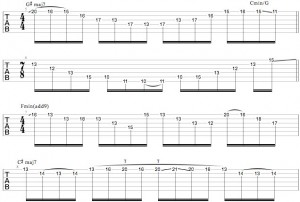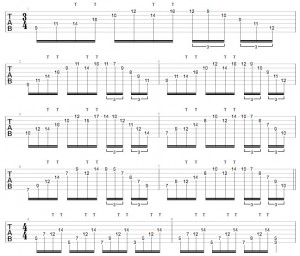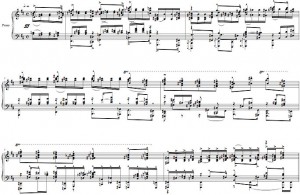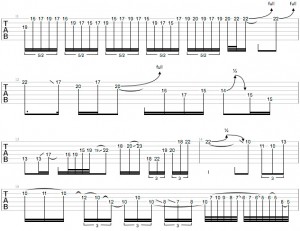Hello Guitar Messenger readers! Today’s lesson focuses on spicing up chords by actively engaging both hands on the fretboard. Don’t be fooled by all the crazy-looking tapping you see in this video – as we move on you’ll realize that this is all a piece of cake. The main thing that I suggest here is to start slow and work your way up. I have provided you with full tracks and backing tracks of the full piece at 160bpm in the beginning, along with versions at 100bpm alongside each exercise, to help you build up to that speed. A few words before we get started – all exercises are performed using hammer-ons from nowhere. Let’s begin!
FULL TRACK (with guitars)
FULL TRACK (no guitars)
Exercise 1A:
The chords are fairly simple. We will be in the key of E Major (E, F#, G#, A, B, C#, D#) for this lesson, but this first example cadences to that key’s relative minor C# Minor, which includes all of the same notes but emphasizes the C#minor chord as our temporary home base. The progression is: C#minor – Amajor – Bmajor – G#7. You might expect to see a G#minor in this key, but this example uses a G#7, taken from C# Harmonic Minor. Changing the chord’s minor 3rd B to the major 3rd B# or C, changes the minor 7th of the Natural Minor scale (R, 2, b3, 4, 5, b6, b7) to the major 7th of the Harmonic Minor scale (R, 2, b3, 4, 5, b6, 7). As you can hear, this makes the cadence back to the C#minor a very strong one!
Now we will add the taps to make things more interesting. My left hand will be playing the root and octave of the chords whilst my right hand will take on elements of the E Major/C# Minor scale. My right hand is tapping the first two notes of an E major scale. What I’m doing is harmonizing these notes separately in 6ths. I start off by making this obvious when playing C#minor – as we move to Amajor, a similar idea takes place, but only for the first 3 notes, after which I continue by tapping an Aadd9 shape. On the Bmajor and G#7 chords, I once again harmonize the first notes in 6ths and proceed to tap within the E Major scale. Practice this very slowly at first to get the motions of both hands in shape, as it may be confusing at first. Watch the video and see how this is demonstrated slowly.
Ex 1A (with guitar)
Ex 1A (no guitar)
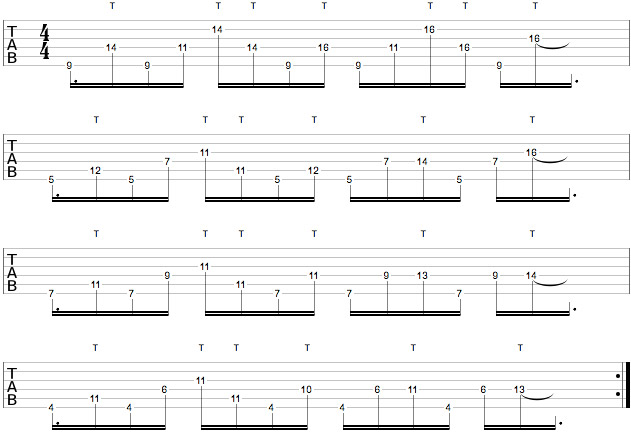
Exercise 1B:
In this ascending pattern we encounter a set of inversions. They can be confusing, but I’m here to make them clear! The chords are: Amajor – Bmajor – Amajor/C# – Bmajor/D#. What those slashes mean is that though the last two chords use C# and D# as roots, they are in fact Amajor 1st inversion and Bmajor 1st inversion chords. This will become apparent when they don’t sound like your typical minor chords.
The left hand plays the root note and the octave as in Exercise 1A, whilst the right hand takes on notes from the E Major scale. As pointed out in the analysis above, notice that once we get to outlining the second two chords, we are faced with notes that correspond to the Amajor and Bmajor 1st inversions.
Ex 1B (with guitar)
Ex 1B (no guitar)
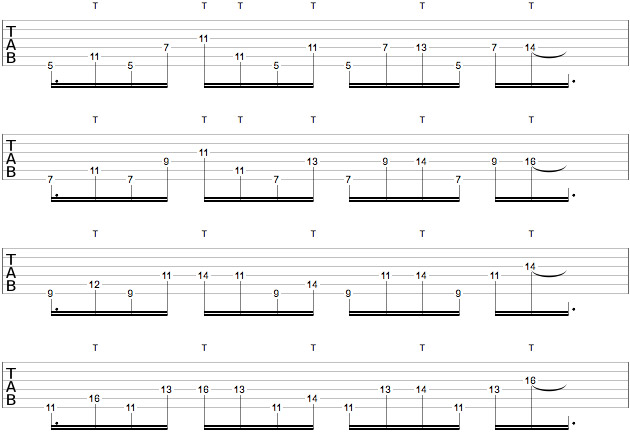
Exercise 2A:
In this section we deal with some interesting tapping patterns. The idea revolves around a monosynth-sounding effect inspired by guitarist Dave Martone. The right hand keeps a consistent pattern tapping notes within an Emajor chord (for the exceptionally detailed musicians, we’re tapping the notes of an Emajor 2nd inversion).
At the same time, the left hand plays a constant shape that descends: Emajor – Dmajor – C#minor – Dmajor. The Dmajor, borrowed from the E Mixolydian scale (E, F#, G#, A, B, C#, D) creates an interesting sound that I can’t seem to get enough of. Watch out for the string-skipping in both hands during the second pass of the progression – those sections might require you to slow the entire example down until you’re comfortable with passing over strings without striking them.
Ex 2A (with guitar)
Ex 2A (no guitar)
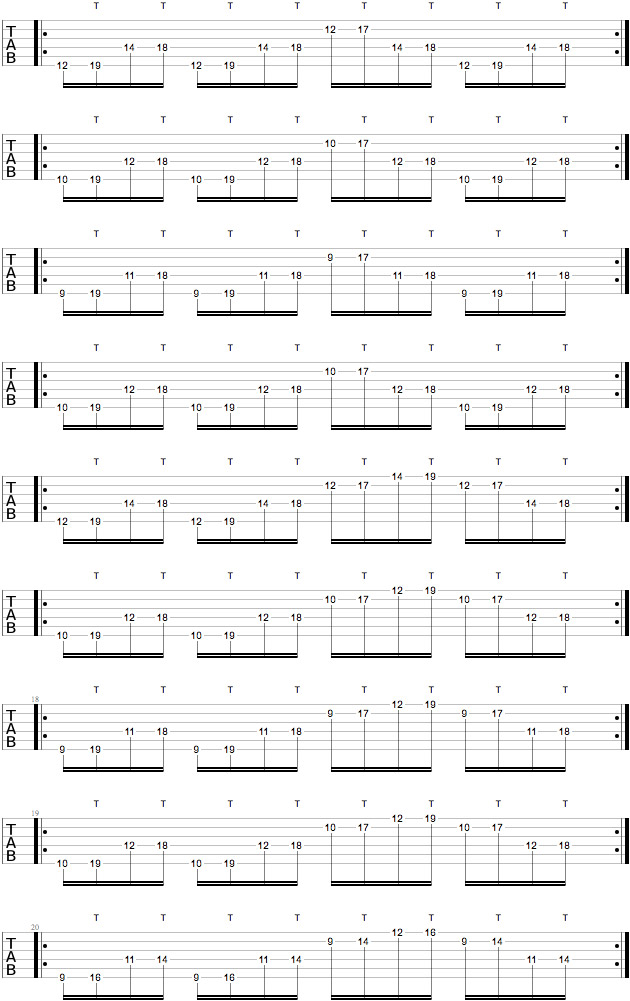
Exercise 2B:
In this section, both the right and left hand move in sync with one another. In the video I show you the difference (in the right hand) between a major and minor shape. All you need to do to make the change is to move the second note you tap down one fret – or in musical terms, you need to flat the 3rd in order to obtain the minor sound.
The chords are: C#minor – Bmajor – F#minor – Amajor – Bmajor. The right hand starts tapping a 5th away from the root note and continues tapping in the pattern I show in the video. The major right hand shape takes a diagonal tapping shape whilst the minor takes a trapezium tapping shape.
Ex 2B (with guitar)
Ex 2B (no guitar)
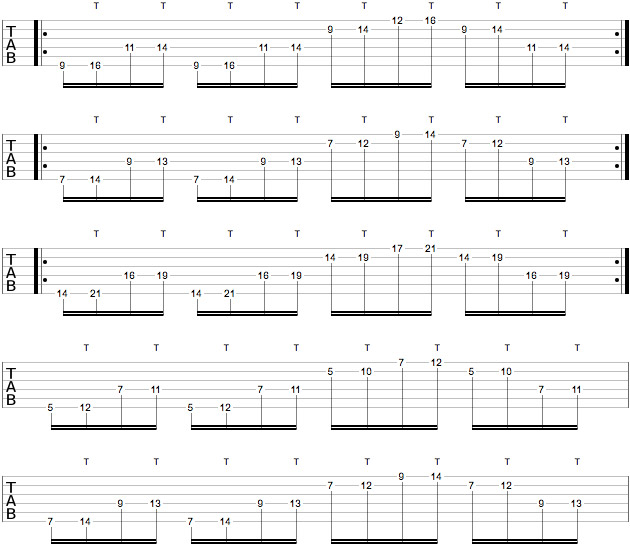
Exercise 2C:
We conclude the piece by returning to an idea similar to what we discussed in Exercise 2A. The right hand will remain constant, whilst the left hand descends chromatically. We start off with a C#minor, to which the right hand will tap a 5th away (G#) in the minor, b3rd/minor 3rd (E) shape we discussed earlier.
It is important to notice the way Amajor and G#major are played here, as the pattern is extended for these two chords. The chromatic descent continues, then jumps up an octave to play the root and 5th of E on adjacent strings, before ending on a strummed C#minor.
Ex 2C (with guitar)
Ex 2C (no guitar)

Tips For Safe Acceleration:
I recommend that you practice this slowly at first. What you need to aim for is getting these licks to sound as clean as possible. Start off very slowly, even slower than the slow backing tracks if necessary, and work your way up to these full-speed tracks gradually. Once you reach a certain speed you’ll notice that playing faster will require higher volume/gain, which is fine as long as you don’t overly distort the sound. Remember to be critical of your playing technique, and preserve cleanliness in your performance of the lick.



